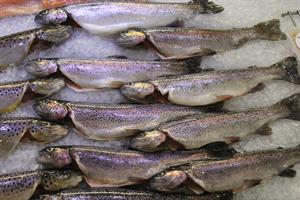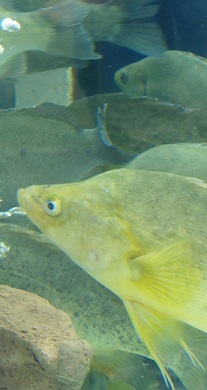Study Freshwater Fish Production and Harvesting
This course shows you how to produce fish and crustaceans in fresh water. (Click here for salt water production.) You'll learn how to get started for small or large setups. Studfy feeding, harvesting, and the basics of running a successful aquaculture business. No previous experience required.

Course Duration: 100 hours
Course Structure
There are 10 lessons in this course.
- Introduction To Aquaculture
- Scope and nature of freshwater aquaculture
- Resources, references, organisations around the world
- Equipment and material suppliers
- Production Systems: EP and IP
- Open, semi closed and closed systems
- Extensive production
- Intensive production
- Water containment: earth, concrete, wood, brick, stone, fibre-glass, liners, etc
- Dams and water storage: siting, site
- Species To Farm
- Selection criteria
- Climate
- Water resources
- Finance
- Scale of operation
- Other resources: manpower, knowledge, support services, etc.
- Market demand and access
- Ecological considerations
- Risk considerations
- Review of different fish: we review many fish and other species suited to farming in Australia,the UK and other countries), including:
- Trout
- Rainbow trout
- Brown trout
- Bass
- Catfish
- Carp
- Cod
- River blackfish
- Marron
- Algae
- Trout
- Three main trout species
- Farming trout
- Water
- Determining flow in source water
- Water temperature
- Water dissolved oxygen
- Stocking rates for production pools
- Spawning trout
- Checking the fish
- Stripping technique
- Fertilisation of ova
- Hatching ova
- From hatch to free swimming stage
- Feed
- After free swim stage
- Barramundi
- Industry perspective
- Breeding and growth rates
- Induced breeding; hormone injection
- Growth
- Fry management and after care
- Grow out
- Pond rearing for larvae
- Barramundi diseases and parasites
- Bass
- Varieties: Australian bass, American loudmouth, Smallmouth
- Habitat requirements: temperature, dissolved oxygen, pH
- Natural spawning cycle
- Controlled spawning
- Harvesting
- Freshwater Crayfish
- Scope and nature of crustacean aquaculture
- Marron and Yabbie
- Conditions: water, temperature, pH, salinity, dissolved oxygen, organic loading, water clarity, pod size
- Initial breeding stocks
- Production potential
- Stocking rates
- Breeding
- Growth
- Feeding
- Composts for Marron feeding
- Red Claw
- Yabbie
- Spiny Freshwater Crayfish
- Setting Up A Fish Farm
- Land and water
- Water requirements
- Extensive production dams
- Intensive production pools and raceways
- Cages
- Biological filtration systems
- Filter efficiency
- Clearing turbid water in dams
- Protecting fish
- Improving genetic quality of fish
- Economics of establishing and running an aquaculture farm
- Financial management
- Financial institutions
- Better planning
- Economics
- What to plan for
- Production
- Marketing
- Fish Foods and Feeding
- Scope and nature
- Pelleted feed
- Live feed
- Brine shrimp
- Daphnia
- Worms
- Night lights
- Fishmeal
- Oil meals
- Fish food production
- Beef heart
- Legumes
- Seafood and vegetable mix
- Earthworm and compost production
- Harvesting
- Introduction
- Harvesting techniques: seine nets, gill nets, traps, long lines, funnel trap, flyke trap, and more
- Fish pumps
- Mechanical graders
- Fish health management
- Review of diseases: salmonids, barramundi, trout, carp, and more
Enrol Today
Ready to get started? Click on the orange enrol now button.
Have questions? Click here to email our course counsellors.
Monitoring Fish is Important

Successful aquaculture depends upon maintaining routine checks of the fish you are growing. If problems are detected quickly, then they are less likely to become too serious; undetected problems can be devastating for an aquaculture installation, small or large.
In order to grow healthy, disease free fish the following all need to be within appropriate levels.You will need to have a test kit that tests pH, ammonia, nitrite and nitrate; and be alert to issues such as the following:
- Water temperature and quality: Temperature is vital to the survival of fish. Temperature fluctuations outside of the normal range for fish species can induce shock in fish and possibly lead to death. The climate of your region will influence the heating and cooling you will need. Water quality is also important and water sources need to be tested. Tap water for example will need to be dechlorinated, tank water too can be problematic especially is the material they are constructed of are leaching toxic chemicals; bore water has a high pH and this will also need to be adjusted. When adding new water to the system you should do so in small quantities to allow the fish to adjust.
- pH: Measure of how acidic or basic (alkaline) the water is. The pH level is usually higher at the beginning of a cycle and then gradually decreases once a system has cycled completely. In general the pH should be between 6.8 and 7.2 – but tolerances can vary slightly outside of that.
- Dissolved oxygen: Dissolved oxygen is required by all fish to survive. The water properties and stocking densities will affect its ability to hold oxygen. For example, warmer water will hold less oxygen. As discussed earlier, in order for fish to survive, the water must be aerated.
- Ammonia: This is the first product of the nitrogen cycle. There are two forms of ammonia. Unionized ammonia is most toxic to fish.
- Nitrite: This is the second product of the nitrogen cycle. Nitrite is produced by the oxidation of ammonia by bacteria and is highly toxic. An increase in ammonia concentrates will be detrimental to fish health. Remove excess feed to prevent this. This problem can be avoided by installing a plumbing off-take from the main pump line. This ensures good water circulation by feeding by into the top of the fish tank. Circulating water keeps the food particles floating and these can then be more easily removed by the pump and filtered back into the grow beds. Adding more fresh water and reducing the pH also limits problems with ammonia excess.
- Algae: Tanks in sunlight can experience problems with algal growth – this is detrimental to health of your fish, the bacteria in your tank or the plants you are growing; place your tank out of sunlight to avoid algae.
- Build up of solids: Some people install a settling tank or swirl separator to remove the larger particles of solids from their tanks, such as fish manure and uneaten food, so that there is not an over load of ammonia or nitrites. This is not totally necessary though as long as you monitor your system carefully; some people think that removing the solids removes fertility from your plants.